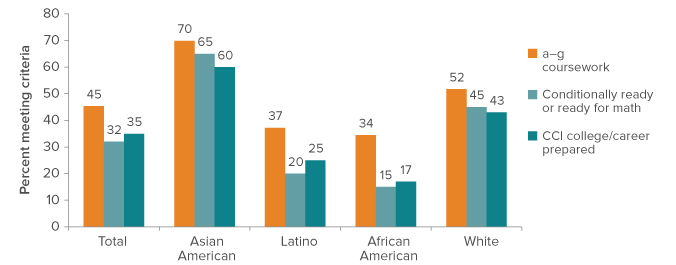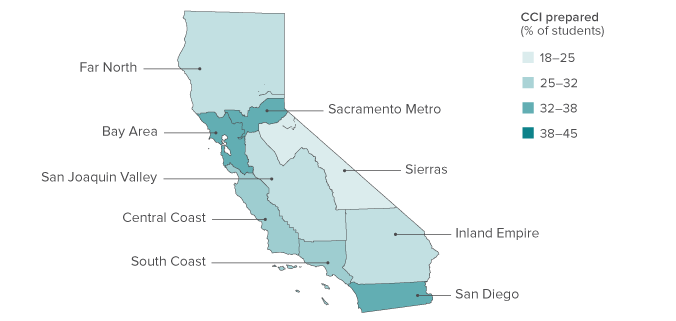- Eligibility for California’s public colleges and universities has several components.
Students become eligible for admission to the University of California (UC) and California State University (CSU) by completing the defined series of high school courses (called a–g), maintaining certain grade point averages, and in some cases, scoring well on college entrance exams such as the SAT. About 40% of California’s high school graduates are eligible for CSU, and about 14% are eligible for UC. All students are eligible to enroll in the state’s community colleges (CCC). - Meeting eligibility requirements alone does not ensure access to college-level courses.
Even after gaining entrance to a college or university, many students have to take remedial courses, which cover high school material and do not count toward a degree. Eight in ten students who enroll at CCC take remediation, compared to three in ten at CSU and less than one in ten at UC. - California provides students with an early measure of their readiness.
The Early Assessment Program uses statewide 11th grade test results to provide students with an indication of their readiness for college-level English and math coursework, which can help them avoid remediation later. Students who score in the highest level are exempt from remedial classes in college and are considered ready for college-level work at all CSU and most CCC campuses. Students scoring in the second-highest level are considered “conditionally ready” and can become fully exempt from remediation by passing certain 12th grade courses. In 2017 about 60% of 11th grade students were ready or conditionally ready in English, compared to about 38% in math. - More students than ever are academically ready for college.
By many measures, California high school students are more likely than ever to be prepared for college. Completion of a–g course requirements has increased more than 28% in 10 years—from 35% of high school graduates in 2006 to more than 45% in 2016. In addition, the state’s new College/Career Indicator (CCI)—which combines a–g completion, standardized test scores, and other indicators—shows that about 35% of all students across the state are prepared for college and/or a career. - Other skills are important for college readiness too.
Students who are the first in their families to go to college (40% of UC and 54% of CSU freshmen) can face other barriers to college readiness, such as knowledge about how to navigate the postsecondary system and how to apply for financial aid. Despite these challenges, Californians are increasingly likely to apply for financial aid. Between 2012 and 2016, the number of high school seniors applying for financial aid increased by 13 percentage points for state financial aid and 5 percentage points for federal financial aid. - College readiness varies across race and region.
There is significant variation across racial/ethnic and regional groups, according to the CCI. White and Asian American students are much more likely than African American and Latino students to be prepared for college. Students in the San Francisco Bay Area and the Sacramento and San Diego regions are far more likely to be prepared than students in more rural areas. Socioeconomically disadvantaged students are half as likely to be prepared as their more prosperous peers.
College readiness varies across racial/ethnic groups

SOURCE: California Department of Education data.
NOTE: Asian American includes Filipino students. Coursework (a–g) based on 2015–16 cohort graduates, conditional readiness on California’s statewide standardized test based on 2017 test-takers in 11th grade. The College/Career Indicator (CCI) defines college and career readiness through a combination of a–g courses, state standardized test scores, dual enrollment course completion, advanced placement exams, international baccalaureate exams, and career technical education pathway completion. “CCI college/career prepared” indicates the percent of 9th grade students from 2013–14 who were prepared by their expected graduation year.
College readiness varies across regions

SOURCE: California Department of Education data.
NOTE: The map relies on the College/Career Indicator (CCI), which defines college and career readiness through a combination of a–g courses, state standardized test scores, dual enrollment completion, advanced placement exams, international baccalaureate exams, and career technical education pathway completion. The map indicates the percent of 9th grade students from 2013 to 2014 who were prepared by their expected graduation year.
- California will hold schools and districts accountable for college readiness.
The state CCI will continue to be updated by the California Department of Education. Starting in 2018, the scores will be included in accountability measures for schools and districts. The CCI acts as a signal to local communities of the progress their schools are making at preparing students for college and/or a career.
